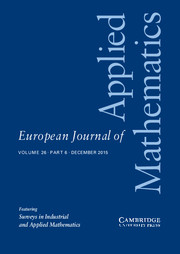New research explores collaborative population dynamics of plants and insects
In order to understand the evolution of nature around us and interact with it in a sensible way, many mathematical models have been proposed to describe populations of plants and animals.
A prominent example is the well-known predator-prey equations, which can be used to build a simple model of the dynamic evolution of biological systems. While the predator-prey model describes a relationship where predators negatively affect the population of prey, models for the reverse also exist. Often, different species collaborate and influence each other’s populations positively, a typical example being the cooperation between flowering plants and pollinating insects.
The simple example of two coupled nonlinear differential equations in predator-prey or cooperative models can be modified and generalized to model further aspects of real-world biological systems. A new article in the European Journal of Applied Mathematics, “Threshold Dynamics Scenario of a Plant-Pollinator Cooperative System with Impulsive Effect on a Periodically Evolving Domain” by Jie Wang, Ruirui Yang, Jian Wang, and Jianxiong Cao, explores such a collaborative population dynamics model involving plants and insects.
One potential extension that has been proposed for population ecology dynamics is the step from classical nonlinear differential equations to impulsive differential equations. Due to seasonal changes, most animal species give birth at specific times of the year, resulting in steep increases in population numbers at regularly repeating points in time. Such changes can be modeled well by discontinuous impulse effects in a population dynamics model. Further examples of negative influences that are described by impulsive effects include the release of natural enemies or the spraying of pesticides.
Another generalizing aspect considered in the paper is the periodically changing domains for the population model. The motivation for this is also based on the specific modeling of plants and pollinators, particularly in the seasonal change of their populations. Typically, the area of rivers and lakes exhibits a regular increase during flood times and decreases during dry seasons, affecting the potential habitat of plants and animal species living around it in a periodic manner.
The main part of the authors’ analysis of these generalized models consists of examining threshold dynamics. This involves identifying the ecological reproduction index R of the pollinators, which is similar to the one known from epidemiology: If the reproduction index is smaller than the critical value of one, a species is not able to reproduce fast enough and will eventually go extinct.
If the reproduction index is larger than one, however, there are solutions to the model in which plant and insect populations can stabilize in a periodically repeating manner. As a central result, the authors prove a closed form of the reproduction index for the cooperative and impulsive plant-pollinator system with a periodically changing domain.
The theoretical results on the reproduction index are further explored in numerical studies, in which the authors implement such a cooperative population dynamics system numerically. As the results show, the evolution rate of the periodically evolving domain is crucial for species’ survival, provided the plants’ isolated reproduction index is larger than one.
If the evolution rate is small, the pollinators’ reproduction index may become smaller than the baseline reproduction index in a non-changing domain and can even drop below the critical value of one. However, if the evolution rate is large, the reproduction index can exceed the baseline. In that case, the change in habitat will actually promote the diffusion of pollinators and their transmission of pollen, and the population sizes of both will converge to positive periodic steady states.
Threshold dynamics scenario of a plants-pollinators cooperative system with impulsive effect on a periodically evolving domain’, by Juan He, Guo-Bao Zhang and Ting Liu. This open access paper is part of Parabolic Equations and Systems in European Journal of Applied Mathematics. Thanks to open access, this paper is free to read, download, and share.
Since 2008 EJAM surveys have been expanded to cover Applied and Industrial Mathematics. Coverage of the journal has been strengthened in probabilistic applications, while still focusing on those areas of applied mathematics inspired by real-world applications, and at the same time fostering the development of theoretical methods with a broad range of applicability.
Survey papers contain reviews of emerging areas of mathematics, either in core areas or with relevance to users in industry and other disciplines. Research papers may be in any area of applied mathematics. A special emphasis is on new mathematical ideas, relevant to modelling and analysis in modern science and technology, and the development of interesting mathematical methods of wide applicability.







